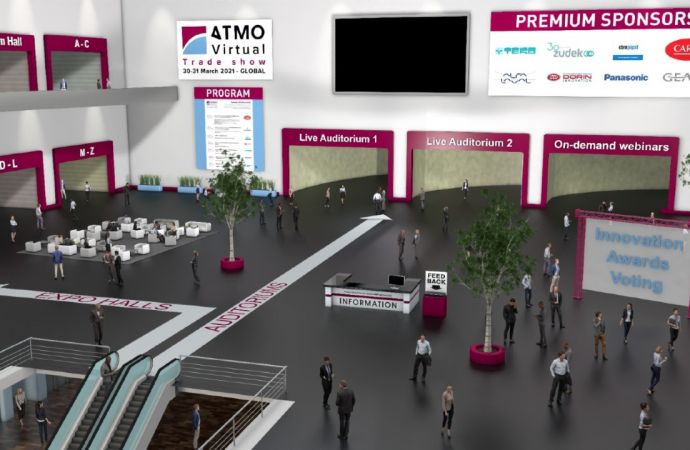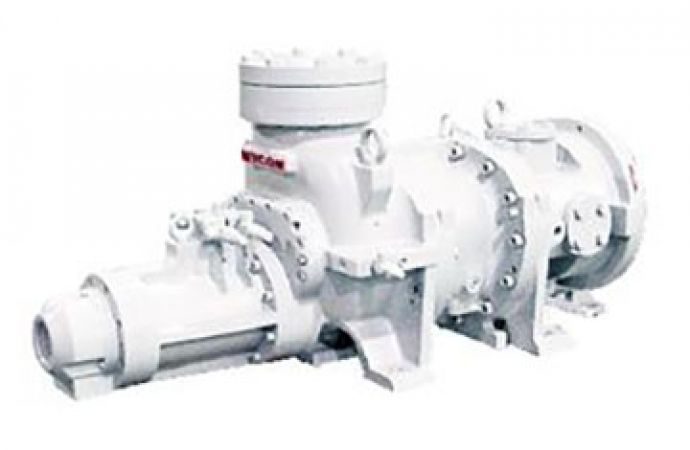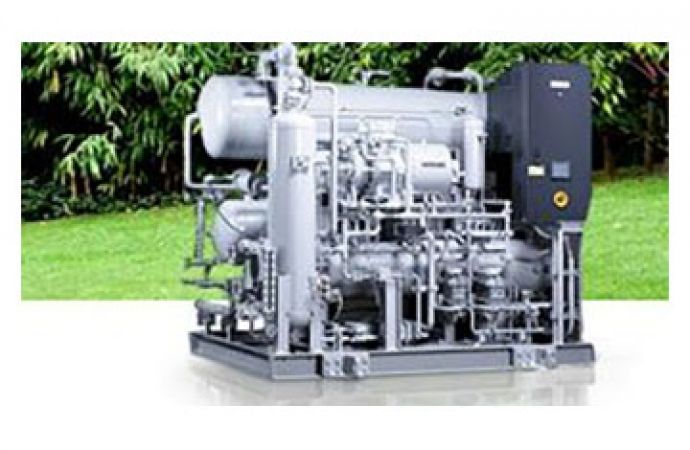Gathering for the first time in Brussels since the EU F-Gas Regulation came into force, ATMOsphere Europe 2015 was the largest to date, with over 230 participants and 60 presenters, including government representatives, technology providers and end-users. Industrial solutions manufacturers Mayekawa and Johnson Controls presented case studies on ammonia heat pumps for hot water production and refrigeration optimisation in food processing applications. In the Market Trends session, Mayekawa looked

Put into today’s European context, Eric Delforge of Mayekawa pointed out in the Market Trends session that the carbon-energy security debate, the different policies in European countries regarding the production and distribution of electricity, and the future outcome of the UN Climate Change Conference to be held in Paris later this year, are all factors contributing to mainstreaming the use of natural refrigerants. But the most prominent factor driving the business at this stage is the recently enforced EU F-Gas Regulation, requiring a reduction in the average GWP of refrigerants from 2000 to 400 by 2030. Outside of Europe, the US and China are also picking up momentum: “Europe is an inspiration to the rest of the world with regards to natural refrigerants,” says Delforge.
Drivers for change and barriers to be overcome
From the end-users’ perspective, taxation on emissions, customer demand for sustainability and accountability, as well as high operational efficiency are all drivers for change. To this, technology providers in industrial sectors are responding with wider equipment availability, less complexity and greater accessibility. “There are many more industry players on the market today, and an increased variety of applications for natural refrigerants,” said Delforge. “Because there is more competition and equipment on the market, the capital costs of these systems can decrease.”
Trends are pointing towards small and medium sized contractors becoming interested in natural refrigerants. Some of the challenges that must be addressed to allow for natural refrigerants to be widely accepted are:
Challenges for technology providers in industrial applications remain minimising refrigerant charge; making operation more simple, reliable and safe; and eliminating leakage. Delforge concludes that what is needed for the evolution of industrial natural refrigerant technology is “inclusive technology incorporating heating and cooling; and local and cross-sector collaboration/ integration.”
A new industry standard for energy optimisation – Cranswick County Foods
Garry Shaw and John Burden of Johnson Controls presented a case study about an industrial heat pump installation at Cranswick County Foods, located in the Watton, Norfolk, in the UK. The goal of the installation was to optimise the refrigeration system of the pig abattoir through installing Sabroe industrial refrigeration heat pump reciprocating compressors.
The case study revealed that the company was able to reduce the energy costs by £500k (€686k) per year, increase the productivity by 30% and decrease the weight loss of the carcasses from 2,3% to 1,4%. This solution set a new industry standard, as it not only monitors and trends the performance of the plant, but also actively hunts for optimal set points to reduce energy usage.
Cranswick is one of the main suppliers of pork products to supermarkets in the UK. It accepted bidders for the overhaul of its plant in 2012 and the project has been operational since November 2013. The company sought to phase-out its R22 and HFC dependency, improve product yield, and reduce the cost on utilities.
Johnson Controls introduced a four stage ammonia/ glycol system composed of:
The cooling COP is 2,3 (LT) and 3.9 (HT), whereas the heating COP is 14. The new system included 5 frequency driven SABROE screw compressors, two SABROE heat pump compressors, a heat recovery system, 65 air coolers, 9 distribution heat pumps, 2 evaporative condensers and a SCADA control system.
NH3 heat pump for hot water production in Belgian bakery facility
Mayekawa Europe’s Jan Boone presented a case study describing an industrial bakery plant located in Mouscron, Belgium, requiring a hot water heat pump for an extension of its production capacity, which would reduce energy consumption and energy costs in order to contribute to the company's sustainability program.
To produce hot water at 65°C an ammonia heat pump was used, with a condensing temperature at 67°C corresponding with a pressure of 29.5 barg. The system also recovers the condenser-heat of the NH3 refrigeration system, resulting in a positive impact on the condenser load and the recovery of residual heat for hot water production. This provides ideal warmth and humidity for the rising of the bread-products in the plant.
The specific demands of the bakery plant were:
The heat pump equipment uses a piston type compressor equipped with frequency convertor for capacity control. The compressor has mechanical cylinder banks which can be unloaded and a 375 kW heating capacity. The final design coefficient of heating performance corresponds to 7,7 at a 30°C evaporating temperature. The actual operating hours in January of 2015 amounted to 7,186.
This cased study shows an annual saving in energy costs of €56.200 and a return on investment within 3 years. The heat pump also has a long lifetime of more than 25 years and low maintenance costs.
Drivers for change and barriers to be overcome
From the end-users’ perspective, taxation on emissions, customer demand for sustainability and accountability, as well as high operational efficiency are all drivers for change. To this, technology providers in industrial sectors are responding with wider equipment availability, less complexity and greater accessibility. “There are many more industry players on the market today, and an increased variety of applications for natural refrigerants,” said Delforge. “Because there is more competition and equipment on the market, the capital costs of these systems can decrease.”
Trends are pointing towards small and medium sized contractors becoming interested in natural refrigerants. Some of the challenges that must be addressed to allow for natural refrigerants to be widely accepted are:
- Enhanced safety by component manufacturers
- Benchmarking of natural refrigerant technologies by consultants and contractors
- Government bodies to better inform, train and control
- Teaching young engineers about natural refrigerant solutions in University
Challenges for technology providers in industrial applications remain minimising refrigerant charge; making operation more simple, reliable and safe; and eliminating leakage. Delforge concludes that what is needed for the evolution of industrial natural refrigerant technology is “inclusive technology incorporating heating and cooling; and local and cross-sector collaboration/ integration.”
A new industry standard for energy optimisation – Cranswick County Foods
Garry Shaw and John Burden of Johnson Controls presented a case study about an industrial heat pump installation at Cranswick County Foods, located in the Watton, Norfolk, in the UK. The goal of the installation was to optimise the refrigeration system of the pig abattoir through installing Sabroe industrial refrigeration heat pump reciprocating compressors.
The case study revealed that the company was able to reduce the energy costs by £500k (€686k) per year, increase the productivity by 30% and decrease the weight loss of the carcasses from 2,3% to 1,4%. This solution set a new industry standard, as it not only monitors and trends the performance of the plant, but also actively hunts for optimal set points to reduce energy usage.
Cranswick is one of the main suppliers of pork products to supermarkets in the UK. It accepted bidders for the overhaul of its plant in 2012 and the project has been operational since November 2013. The company sought to phase-out its R22 and HFC dependency, improve product yield, and reduce the cost on utilities.
Johnson Controls introduced a four stage ammonia/ glycol system composed of:
- Low temperature ammonia at -33°C x 1,700 kW
- Medium temperature ammonia at -12°C x 600 kW
- Secondary water/glycol at -8°C x 1,000 kW
- High temperature heat pump at +60°C x 950 kW
The cooling COP is 2,3 (LT) and 3.9 (HT), whereas the heating COP is 14. The new system included 5 frequency driven SABROE screw compressors, two SABROE heat pump compressors, a heat recovery system, 65 air coolers, 9 distribution heat pumps, 2 evaporative condensers and a SCADA control system.
NH3 heat pump for hot water production in Belgian bakery facility
Mayekawa Europe’s Jan Boone presented a case study describing an industrial bakery plant located in Mouscron, Belgium, requiring a hot water heat pump for an extension of its production capacity, which would reduce energy consumption and energy costs in order to contribute to the company's sustainability program.
To produce hot water at 65°C an ammonia heat pump was used, with a condensing temperature at 67°C corresponding with a pressure of 29.5 barg. The system also recovers the condenser-heat of the NH3 refrigeration system, resulting in a positive impact on the condenser load and the recovery of residual heat for hot water production. This provides ideal warmth and humidity for the rising of the bread-products in the plant.
The specific demands of the bakery plant were:
- Production of 100 m3/day of hot water at 65°C with a heating capacity of 300 kW per hour
- 70 m3/day of warm water at 25°C for dough-proofer, with a heating capacity of approx. 65 kW
- Cooling of 2,5 MW at -30°C and 1 MW at -10°C
- -30°C freezing, for which an ammonia pump circulation and direct expansion was used
The heat pump equipment uses a piston type compressor equipped with frequency convertor for capacity control. The compressor has mechanical cylinder banks which can be unloaded and a 375 kW heating capacity. The final design coefficient of heating performance corresponds to 7,7 at a 30°C evaporating temperature. The actual operating hours in January of 2015 amounted to 7,186.
This cased study shows an annual saving in energy costs of €56.200 and a return on investment within 3 years. The heat pump also has a long lifetime of more than 25 years and low maintenance costs.
MORE INFORMATION
Related stories







